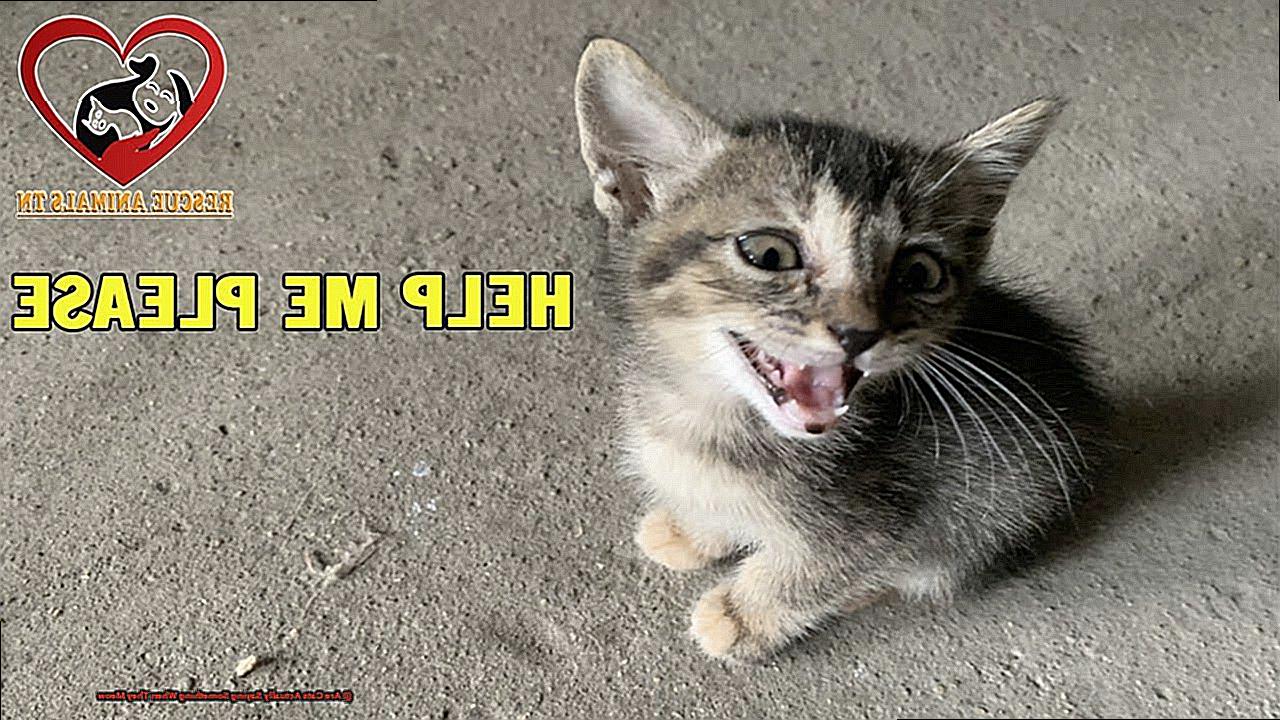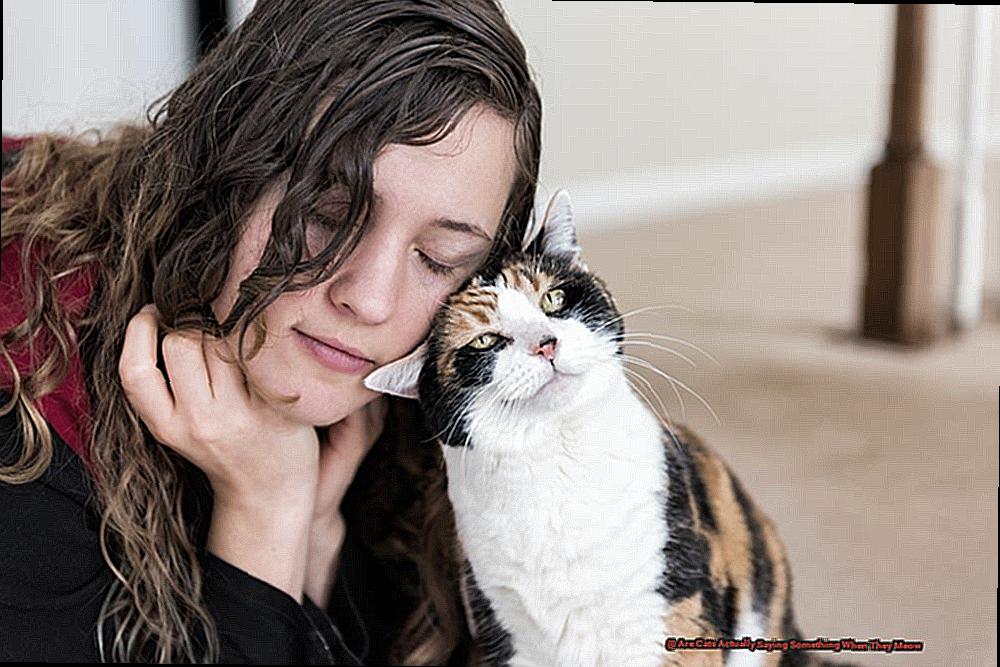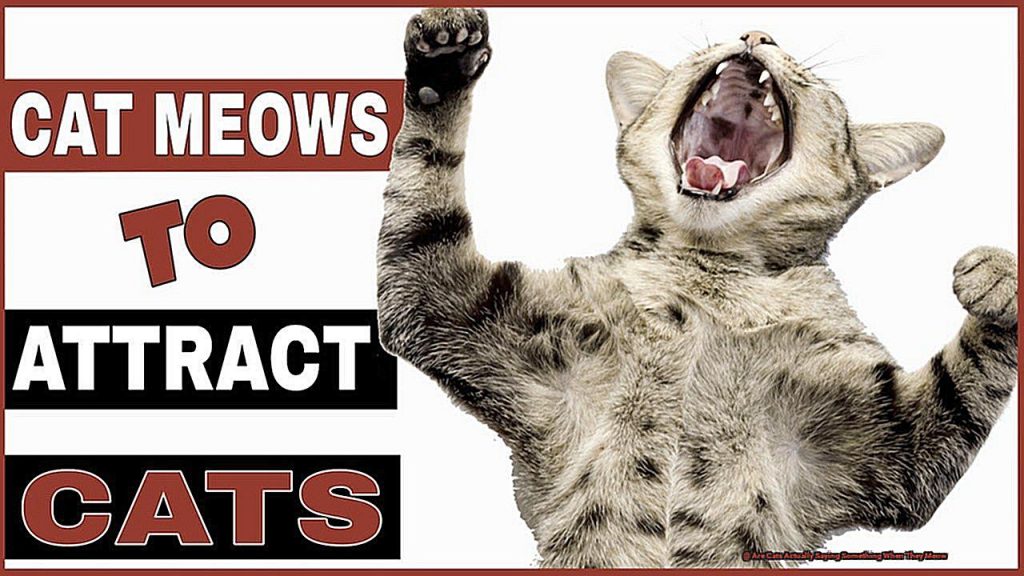Do you ever find yourself wondering what your furry companion is trying to say when they let out a meow? As a fellow cat parent, I am constantly intrigued by the various vocalizations my feline friend makes.
Whether it’s a soft and gentle meow or a loud and persistent one, each sound seems to hold its own unique message. But what exactly are they trying to convey?
So grab your favorite feline friend, get cozy, and let’s unravel the secrets behind their meows together.
Are Cats Actually Saying Something When They Meow?
Contents
Many people believe that cats meow to communicate with humans, but the truth is, they primarily use meowing to communicate with each other. So, why do cats meow to humans, and what are they trying to convey? Let’s take a closer look.
Meowing: A Learned Behavior
Contrary to popular belief, cats do not meow to each other in the wild. Instead, they develop this behavior specifically to communicate with humans. According to experts, kittens meow to their mother for food and attention, but as they grow up and no longer need their mother’s care, they stop meowing to each other. However, they continue to meow to humans as they have learned that it can get them what they want.
Different Types of Meows and Their Meanings
Just like human language, different types of meows may have different meanings. For example, a short and high-pitched meow may indicate excitement or greeting, while a longer and lower-pitched meow may convey hunger or frustration. By paying attention to the context and tone of your cat’s meow, you can better understand what they may be trying to communicate.
Manipulative Meows?
Some experts suggest that cats may use meowing as a way to manipulate humans. If a cat wants something from its owner, it may use a more urgent or persistent meow to get their attention. This behavior has been observed in cats who have learned that meowing can get them what they want. So, it’s essential not to always give in to your cat’s demands when they meow.
Body Language is Key
While meowing is one way for cats to communicate with humans, it is not their primary form of communication. Cats primarily use body language and scent marking to communicate with each other, so it is essential to pay attention to your cat’s body language as well. Tail position, ear movement, and facial expressions can all give clues about what your cat may be trying to say.
The Evolution of Meowing in Cats
As a proud cat owner, I am sure you have experienced the joy of hearing your feline friend meow. But have you ever wondered why cats meow? How did this behavior evolve in our beloved pets? In this section, I will delve into the fascinating world of cats and their evolution of meowing as a form of communication.
From Wild to Domesticated: The Origin of Meowing
Historically, cats have not been known to meow as a form of communication. In fact, wild cats do not meow at all. It is believed that they have evolved this behavior from their relationship with humans. The ancestor of domesticated cats, the African wildcat, communicates through growls, hisses, and purrs. These sounds are used to communicate with other cats and predators.
Meowing: A Learned Behavior
Cats began to meow as a response to human vocalizations and body language. It is believed that they learned to use meowing as a way to get attention and food from humans. This theory is supported by the fact that kittens meow more than adult cats. They quickly learn that if they meow, their mother will come and provide them with food and attention.
Not All Meows Are Created Equal
Did you know that different breeds of cats have different types of meows? For example, Siamese cats are known for their loud and persistent meows, while Persian cats tend to have softer and shorter meows. This further supports the idea that meowing is a learned behavior, as it can vary depending on the breed.
The Context of Meowing
Meowing in cats also varies depending on the situation. A cat may use a different tone of meow when asking for food compared to when they want attention or when they are in pain. As cat owners, it is important for us to pay attention to the context and tone of our cat’s meows to better understand their needs and emotions.
The Bond between Cats and Humans
Through domestication, cats have adapted their communication skills to better interact with humans. Meowing has become an important part of their communication repertoire and is used to convey a wide range of emotions and needs. Studies have shown that cats are more likely to meow at humans who they have a close relationship with, further emphasizing the strong bond between felines and humans.
Learned Behavior or Natural Instinct? Debunking the Myth
Meow. It’s a sound that every cat owner knows well. Whether it’s a soft and gentle meow or a loud and persistent one, our feline friends are experts at getting our attention. But have you ever wondered why cats meow? Is it a form of direct communication with humans, or is there more to it than meets the eye?
Let’s debunk the myth and uncover the truth behind this common behavior in our beloved cats.
Meowing is a learned behavior, not a natural instinct.
Contrary to popular belief, meowing is not a natural instinct for cats. In the wild, adult cats do not meow to communicate with other cats. They use other vocalizations such as hissing, yowling, and purring to communicate with their feline companions.
So why do domesticated cats meow? As kittens, they learn to meow as a way to communicate with their mothers. This behavior is reinforced through positive responses from their mothers, who in turn provide food and care. As adult cats, they continue this behavior with humans because they have learned that it gets them what they want.
Cats have evolved to use meowing as a way to communicate with humans.
But why do cats choose to communicate with us through meowing instead of using their natural vocalizations? The answer lies in the strong bond between cats and humans. Domesticated cats have evolved alongside humans for thousands of years, and as a result, they have developed the ability to understand and communicate with us in their own unique way.
Some experts also suggest that meowing may be a cat’s attempt at imitating human vocalizations. After all, we are their primary caregivers and sources of food, so it makes sense for them to try to mimic our sounds in order to get our attention and communicate their needs.
However, it’s important to note that when your cat meows, they are not actually saying words or phrases like we do. Meowing is simply a form of communication that has been adapted by domesticated cats for their own benefit.
Meowing is a form of communication, not a direct conversation.
As cat owners, we often find ourselves trying to decipher what our cats are trying to tell us with their meows. While it may sound like they are saying “hello” or “I love you,” the truth is that cats are not capable of understanding or speaking human language.
Decoding Different Types of Meows and Their Meanings
Contrary to popular belief, meowing is not just a demand for food or attention. Cats have a complex and unique way of communicating, and meowing is one of their most common forms of expression. As an expert on decoding cat meows, I am here to help you understand the different types of meows and their meanings.
First and foremost, it’s important to know that not all meows are created equal. Just like humans, cats have different types of meows for different situations and needs. One common type is the greeting meow, which is a short and high-pitched sound used to greet their owners or other cats. This meow is often accompanied by a head rub or a tail wag, a sign of affection and happiness.
Another familiar type is the demand meow, which is characterized by a loud and insistent tone. This type of meow is often used when cats want something specific, such as food or to be let outside. On the other hand, the pleading meow is softer and more drawn out, used when your feline friend wants attention or affection from you.
But what about those low-pitched, almost growling meows? Those are warning meows that can signal danger or discomfort. It’s essential to pay attention to these warnings and identify the source of your cat’s distress.
Some cats also have a chirping or trilling meow, which is a combination of a purr and a meow. This type of meow is often used when cats are excited or trying to get their owner’s attention. It’s like their way of saying “hey, look at that bird outside.”
It’s important to note that not all cats use the same types of meows, and some may have unique variations depending on their breed or personality. So, it’s crucial to pay attention to your cat’s specific meows and their context to better understand their needs and wants.
But why do cats meow in the first place? Research has shown that meowing is not a natural behavior for cats, as they primarily use body language and scents to communicate with each other. However, domesticated cats have learned to meow to communicate with humans, and they can develop different types of meows for different needs. Plus, let’s be honest, they quickly learn that meowing can get them what they want from us.
Next time your cat starts meowing at you, take a moment to observe their body language and listen to the tone and pitch of their meow. It can give clues to their mood and needs. For example, if your cat is rubbing against your leg while meowing, it may be asking for affection or attention. And remember, communication is a two-way street. Responding positively to your cat’s meows can strengthen the bond between you and your feline companion.
How to Interpret Context and Tone in a Cat’s Meow
As cat owners, we know that our furry companions have a special way of communicating with us. Whether it’s through their purrs, body language, or meows, cats have a unique language that they use to express their needs and emotions. And while meowing may seem like a simple form of communication, there is much more to it than meets the eye.
In this blog post, we will dive into the world of cat meows and learn how to interpret their context and tone. By understanding these elements, you can better understand your cat’s needs and strengthen your bond with them.
Understanding the Different Types of Meows
Firstly, it’s essential to know that not all meows are created equal. Cats use different types of meows to convey different messages. For example, a short and high-pitched meow may indicate excitement or a greeting, while a long and drawn-out meow could mean frustration or a demand for attention.
Other types of meows include demanding meows, which are used to communicate a desire for food or playtime, and affectionate purrs, which express contentment and happiness. By paying attention to the type of meow your cat uses, you can start to decipher their message.
Interpreting Context Through Body Language
Like humans, cats also use body language to communicate. And when paired with a meow, it can provide valuable insight into what your cat is trying to say. For example, if your cat is rubbing against your leg while meowing, it could mean they want attention or affection. On the other hand, if their ears are flattened and their tail is flicking back and forth while meowing, it could signify annoyance or aggression.
Identifying Tone Through Pitch and Volume
The pitch and volume of a cat’s meow can also reveal their tone and emotions. A high-pitched and urgent meow may indicate distress or a need for attention, while a low-pitched and drawn-out meow could mean contentment or a desire for affection. By paying attention to these cues, you can better understand your cat’s emotions and respond accordingly.
Recognizing Emotions Behind Meows
Just like humans, cats have a wide range of emotions, and they use different meows to express them. For example, a short and soft meow may indicate happiness or contentment, while a long and loud meow may signify frustration or anger. By understanding the emotions behind your cat’s meows, you can better cater to their needs and provide them with the care they deserve.

The Role of Body Language and Scent Marking in Feline Communication
As cat owners, we often find ourselves trying to decipher the meows and purrs of our feline companions. But did you know that cats have a complex communication system that goes beyond vocalizations? In their natural environment, cats rely heavily on body language and scent marking to convey emotions and information to other cats. As a specialist in feline communication, I am here to share with you the fascinating world of non-verbal communication in cats.
Body Language: It’s all in the Tail
Have you ever noticed how your cat’s tail moves in different ways? That’s because tail movements are an essential part of their body language. A raised tail indicates a friendly or playful mood, while a lowered tail can signal fear or aggression. A twitching tail can mean excitement or annoyance, depending on the context. Similarly, the position of their ears can also convey a lot of information. Flattened ears can indicate fear or submission, while upright ears show alertness.
Facial expressions are also crucial in cat communication. A relaxed cat will have their eyes half-closed, while a tense or scared cat will have wide-open eyes. They may also bare their teeth or hiss to show aggression.
Scent Marking: The Secret Language of Cats
Cats have scent glands on various parts of their bodies that release pheromones, chemical signals that convey information to other cats. Through urine, feces, and scratching, cats mark their territory and communicate with each other. The location and intensity of these markings can convey messages such as territorial boundaries, mating availability, and social status.
Understanding your cat’s scent marking behavior can also help prevent unwanted behaviors like spraying or scratching furniture. By providing them with appropriate scratching posts and regularly cleaning litter boxes, you can help satisfy their natural instinct to mark their territory.
The Importance of Understanding Your Cat’s Non-Verbal Communication
As cat owners, it is essential to understand our feline companions’ non-verbal communication. It not only strengthens our bond with them but also helps us better meet their needs and prevent potential conflicts. By recognizing when our cat is feeling scared or agitated, we can provide them with a safe and comfortable environment. Similarly, understanding their scent marking behavior can help us address any territorial issues and maintain a harmonious household.
Why Do Cats Meow at Humans?

Unlike other animals, cats do not meow to communicate with each other. They primarily use body language and scents to communicate with other cats. But when it comes to humans, they seem to have a whole different system of communication. So why do cats meow at humans? Let’s explore some of the reasons behind this behavior.
Communication
The most common reason for a cat’s meowing is to communicate with us. They use their vocalizations to get our attention and express their needs and desires. This behavior starts in kittenhood when they meow to their mothers for food, warmth, or when they are in distress. As they grow older, they learn that meowing can also get them what they want from humans. So it becomes a learned behavior that continues into adulthood.
Manipulation
Some experts believe that cats have learned to mimic the sounds of human babies in order to manipulate us. They know that we respond to the cries of a baby, so they use a similar tone and pitch in their meows to get our attention. This theory is supported by the fact that cats tend to meow more at night when we are asleep and less likely to give them attention.
Greeting
Cats may also meow as a way of greeting us or acknowledging our presence. This is especially common among social and affectionate cats who enjoy human company. A short meow can be their way of saying hello.
Affection
We often think of purring as a sign of affection from cats, but did you know that meowing can also be a way for them to express their love? Some cats will purr and meow simultaneously while rubbing against us or sitting on our laps. This behavior is a way for them to show us that they are happy and content in our company.
Discomfort or pain
Cats may also meow to communicate discomfort or pain. When they are sick or injured, their meows may sound different than usual. As responsible pet owners, it’s important for us to pay attention to any changes in our cat’s vocalizations as it may be a sign of an underlying health issue.
Conclusion
When it comes to the age-old question of whether cats are actually saying something when they meow, the answer is not a simple yes or no.
While cats do use meows as a form of communication, it’s important to understand that their vocalizations can have various meanings and may not always be directed at humans. These feline creatures have their own unique ways of expressing themselves, and it’s up to us to decipher their messages.






